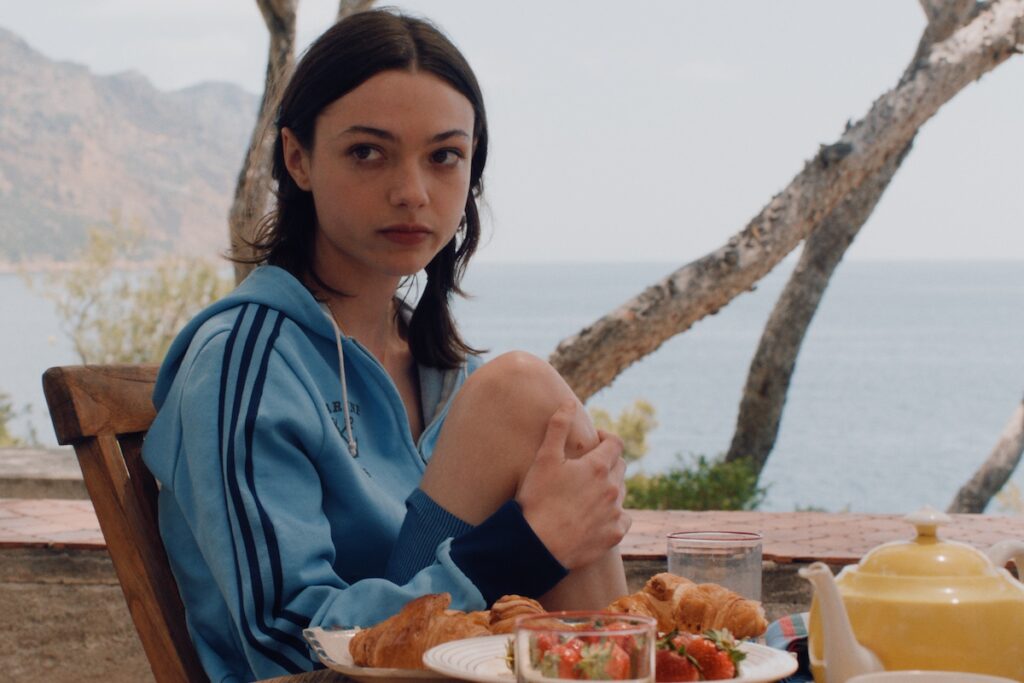‘Bonjour Tristesse’ Explores Summertime Sadness in the South of France
Favoring aesthetics over storytelling, the film is at times obscure and vague, and it wouldn’t be surprising if those unfamiliar with the tale’s basic outline consider it a frustrating viewing experience.

One of the best decisions first-time filmmaker Durga Chew-Bose made in her adaptation of the French novel “Bonjour Tristesse” was to cast Chloë Sevigny. An “It Girl” during the 1990s, appearing in films like “Kids” and “Boys Don’t Cry,” for which she received an Oscar nomination, the actress now exudes a certain middle-aged hauteur while maintaining her staunch hipster demeanor — she lives in New York — and a highly curated wardrobe.
The qualities are perfect for the role of Anne, who is described in the novel as a discriminating fashion designer with imperviable poise. Anne is also the only character to really concern herself with young protagonist Cécile, and Ms. Sevigny gives Anne a nurturing aspect in keeping with a woman who finds that no one is looking out for or formally mentoring a motherless 17-year-old girl vacationing in the south of France.
Another smart decision by Ms. Chew-Bose was selecting Lily McInerny to play Cécile. The young New Yorker looks more like a 17-year-old than Jean Seberg did in the 1958 Hollywood movie version, despite actually being older than Ms. Seberg was when she played the role. Ms. McInerny also depicts the character’s teenage insecurity, carelessness, and craftiness with a more genuine feel for ambivalence, in keeping with the new independent film’s subtle approach and quietly observational, languorous mood.
It’s this tone, though, that keeps the novel’s themes at a distance and its storyline feeling inconsequential, as if the director were embarrassed by the book’s melodramatic aspects. The prior Otto Preminger-helmed movie may have amped up the drama, but there was no doubt as to the characters’ motivations nor disbelief at how the plot unfolded. Unfortunately, Ms. Chew-Bose seems to have little idea about how to craft a narrative that connects small moments to big scenes, resulting in major plot developments appearing out of thin air. Favoring aesthetics over storytelling, the film is at times obscure and vague, and it wouldn’t be surprising if those unfamiliar with the tale’s basic outline consider it a frustrating viewing experience, despite the gorgeous setting.

A sort of elevated beach read, the 1954 book by Françoise Sagan tells an admittedly sordid story: At a seaside villa, Cécile and her widowed father Raymond enjoy a sun-baked vacation with Elsa, his latest in a long line of lovers. Raymond is lovingly laissez-faire when it comes to his daughter, almost to the point of irresponsibility and immoral influence.
While at the beach, Cécile meets a young man, Cyril, and the two begin a summer romance. Then when Anne, an old friend of Raymond and Cécile’s mother, turns up, the easy-going atmosphere changes due to Anne’s stricter sense of decorum and propriety. Soon, Anne and Raymond fall in love and announce their intention to marry, and confused and distressed Cécile plots to have their relationship fail by staging public displays of affection between Cyril and Elsa to make her father jealous, ultimately leading to a tragic outcome.
Placid yet suggestive, the first 30 minutes or so succeed in establishing the dynamic between the characters and the unsupervised rhythm of Cécile’s time. Quick shots of the brutalist villa’s handsome interiors and environs enchant, with still life detailing, like flowers frequently on the periphery, lending a fine art photography vibe to the proceedings.
Soon, though, one begins to want more out of the bland summery dialogue, with Ms. Chew-Bose, who also wrote the screenplay, often taking snippets from the novel and expanding them into longer conversations of cocktail party-type chatter featuring scant character insight. Arthur Laurents’s script for the earlier film may have been filled with expository lines, added humor, and too-emphatic statements, yet he and Preminger knew how to build up to and sustain a dramatic scene, not just hint at portent with pseudo-poetic pronouncements.
Updating the story with contemporary technology, Ms. Chew-Bose nonetheless ignores the current era’s social mores, particularly regarding Raymond. Cécile’s father’s behavior can be seen as a minefield of oblivious inappropriateness, though the film minimizes his womanizing tendencies, and it’s somehow both refreshing and disappointing that the writer-director didn’t choose to interrogate this aspect. For his part, Danish actor Claes Bang portrays Raymond as a subdued, lovable rake, sometimes making a witty remark and affecting a fatherly pose, but generally self-centered, decadent, and clueless to how his conduct affects his daughter.
Regrettably, his rapport with Ms. Sevigny is next to nil, primarily because their relationship is never allowed to blossom naturally — just abruptly. Both actors’ performances don’t quite measure up to those of David Niven and Deborah Kerr in the first movie, though Ms. Sevigny comes close in her scenes with Ms. McInerny and when she hints at Anne’s yearning.
The philosophical musings in Ms. Sagan’s prose are nowhere to be found, with French philosophers Henri Bergson, whom Cécile is studying, and Sartre never mentioned. This leads one to wonder why no major French director, such as the brilliantly rigorous and salacious Catherine Breillat, has ever tackled the novel. Perhaps it has something to do with its air of lycée existentialism, or that many French auteurs, including Godard, considered the Preminger version to be top-notch. Whatever the reason, it tells a potent coming-of-age story that is ready to be used as a launchpad for a more inspired interpretation.

